REFLECTIONS ON L.A. DANCE PROJECT
The uneven and uninspiring effort presented by L.A. Dance Project last night isn’t bad news; it just means that this nascent company needs to hone its vision if it ever wants to be a world-class company. The perplexing title 3 Exceptional Performances may speak to the company’s ambitions, but the final product certainly wasn’t exceptional, as in 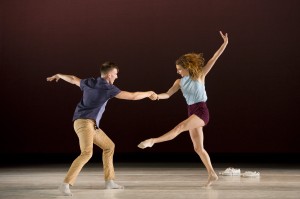 “rare,” “superior,” or “extraordinary.”
“rare,” “superior,” or “extraordinary.”
It is remarkable that L.A. is teeming with dancers yet is sorely lacking in major companies. When L.A. Dance Project was conceived by founding director Benjamin Millepied four years ago, I was hoping that we would finally see some seasonal programs in lieu of another Nutcracker, yet this company’s steady worldwide schedule has only included the city it was born in twice: a one-time event at Disney Hall in Sep., 2012 (with a world premiere by dancer/choreographer Millepied) and as a collaborator with The Industry on Invisible Cities at Union Station in 2013.
It seems the company has a lot of money and prestige behind it. Consider that Millepied, already a globetrotting dancemaker before choreographing and appearing in Darren Aronofsky’s Black Swan (2010), is now a celebrity of the dance world, and it’s impossible for L.A. Dance Project to be his priority. The man from Bordeaux, 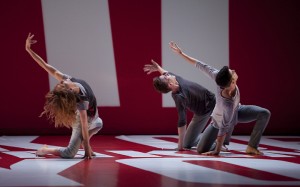 France, renowned for his superabundant work ethic and charisma to match, is the face of Yves Saint Laurent’s fragrance l’homme libre, and is leaving L.A. with his wife, actress Natalie Portman, to become Director of Paris Opera Ballet this fall.
France, renowned for his superabundant work ethic and charisma to match, is the face of Yves Saint Laurent’s fragrance l’homme libre, and is leaving L.A. with his wife, actress Natalie Portman, to become Director of Paris Opera Ballet this fall.
He will remain a creative force, but he leaves behind a company made up of eight dancers with no Artistic Director. Instead, there is a Creative Collective: composer Nico Muhly, art consultant Matthieu Humery, and Founding Producers Charles Fabius and Nicholas Britell. Their mission is to promote new collaborative work in both traditional and non-traditional spaces, and revisit multidisciplinary dance collaborations from the past.
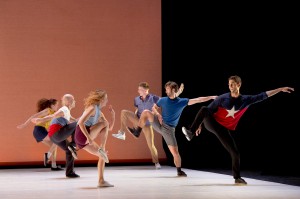 The event was ill-prepared off stage, but the company was well-prepared on, and the program at hand certainly included wonderful visual installations and newer compositions. The dancers were well-chosen, but some definitely outshined others. All three pieces—which were difficult to follow—may have added up to sixty minutes of dance time, but the evening started late and lasted two and one half hours, including two intermissions. The two full-length works, Millepied’s Reflections (30 minutes, 2013) and Justin Peck’s Murder Ballades (20 minutes, 2013), already premiered in France.
The event was ill-prepared off stage, but the company was well-prepared on, and the program at hand certainly included wonderful visual installations and newer compositions. The dancers were well-chosen, but some definitely outshined others. All three pieces—which were difficult to follow—may have added up to sixty minutes of dance time, but the evening started late and lasted two and one half hours, including two intermissions. The two full-length works, Millepied’s Reflections (30 minutes, 2013) and Justin Peck’s Murder Ballades (20 minutes, 2013), already premiered in France.
* * * * * * * * * * * * * * * * * * * *
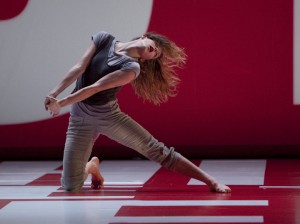 Millepied’s Reflections is set to selections from David Lang’s This was written by hand/memory pieces (2011), played live on piano by Gloria Cheng, placed audience left below the stage. The music changed tone for each section of the piece: Tentative and luxurious like George Winston; impressionistic like a quick-tempoed Debussy; repetitively minimalistic like Philip Glass; and one part can best be described as someone practicing piano while simultaneously dusting off the keys. While the music may have inspired the choreography, created in collaboration with company dancers, the music didn’t always synch with the movement. (Collaborators Julia Eichten, Charlie Hodges, Morgan Lugo, and Nathan Makolandra were seen on stage, but Amanda Wells retired from the company last year; her part is now danced by Rachelle Rafailedes.)
Millepied’s Reflections is set to selections from David Lang’s This was written by hand/memory pieces (2011), played live on piano by Gloria Cheng, placed audience left below the stage. The music changed tone for each section of the piece: Tentative and luxurious like George Winston; impressionistic like a quick-tempoed Debussy; repetitively minimalistic like Philip Glass; and one part can best be described as someone practicing piano while simultaneously dusting off the keys. While the music may have inspired the choreography, created in collaboration with company dancers, the music didn’t always synch with the movement. (Collaborators Julia Eichten, Charlie Hodges, Morgan Lugo, and Nathan Makolandra were seen on stage, but Amanda Wells retired from the company last year; her part is now danced by Rachelle Rafailedes.)
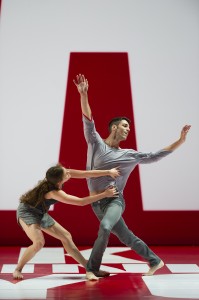 Millepied fits squarely into modern dance, but we can see a foundation in classical ballet and especially Robbins and Balanchine. I have seen five of his works and they seem sporadically organized. I have yet to figure out his meaning, but there’s nothing wrong with watching an interesting series of fluctuating bodies seemingly used for nothing more than visual effect.
Millepied fits squarely into modern dance, but we can see a foundation in classical ballet and especially Robbins and Balanchine. I have seen five of his works and they seem sporadically organized. I have yet to figure out his meaning, but there’s nothing wrong with watching an interesting series of fluctuating bodies seemingly used for nothing more than visual effect.
The dancers performed in front of artist Barbara Kruger’s vibrant backdrops of red with two alternating giant white words on them: “Stay” and “Go.” I would find out later that the phrase “Thinking of you thinking of me” could be seen on the stage floor by those in the balcony, but it was not visible to orchestra patrons in the 1600-seat Theatre at Ace Hotel. Even had I seen this phrase, the words would have been peripheral to the piece.
Kruger’s grey-toned costumes seemed to say, “Let’s go for a hike in Runyon Canyon.” The series of dances began with a playful, swaying, sensual, and graceful but somehow pensive pas de deux, which explored the differences between the short, solid Eichten and the tall, fluid Lugo, as if they were in the beginning of a relationship and figuring out how to support each other.
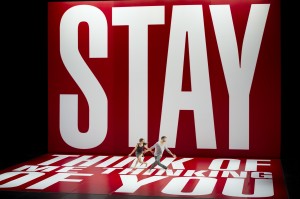 The next part highlighted the most electrifying dancer of the night: Charlie Hodges. This brawny and fast-paced livewire showed off how proud he was of merging classical spins with modern dance in an exciting solo, infused with a classic athleticism he gleaned from his years with Twyla Tharp. This is followed by an argumentative duet with Rafailedes and Makolandra; a tenderhearted meeting in silence between Hodges and Lungo; and a flux group scene which includes impressive arabesques from Hodges. At long last, it ends with two women in silence mirroring the opening pas de deux, emphasizing, I believe, life’s momentary passages of yearning and need.
The next part highlighted the most electrifying dancer of the night: Charlie Hodges. This brawny and fast-paced livewire showed off how proud he was of merging classical spins with modern dance in an exciting solo, infused with a classic athleticism he gleaned from his years with Twyla Tharp. This is followed by an argumentative duet with Rafailedes and Makolandra; a tenderhearted meeting in silence between Hodges and Lungo; and a flux group scene which includes impressive arabesques from Hodges. At long last, it ends with two women in silence mirroring the opening pas de deux, emphasizing, I believe, life’s momentary passages of yearning and need.
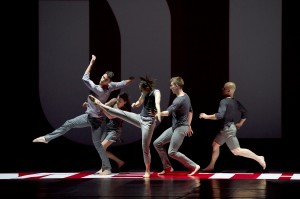 There is an accent on flowing upper-body moves in the entire piece, which is great for the tall, thin men with their long arms, but the women simply didn’t stand out. The piece was strangely unemotional, meandered, and either lacked clarity or overstayed its welcome, but it always kept my attention, which is huge. I loved how the dancers depended on each other; Reflections took a lot of trust and a lot of rehearsal—and a lot of money: Millepied’s connections brought in financing from the jewelers Van Cleef and Arpels for Reflections, the first part of a planned triptych entitled Gems. The next two sections are to be created by other teams collaborating with Millepied. It seems the commissioned triptych is correlative of Balanchine’s Jewels, but so far there are no “gems” in sight.
There is an accent on flowing upper-body moves in the entire piece, which is great for the tall, thin men with their long arms, but the women simply didn’t stand out. The piece was strangely unemotional, meandered, and either lacked clarity or overstayed its welcome, but it always kept my attention, which is huge. I loved how the dancers depended on each other; Reflections took a lot of trust and a lot of rehearsal—and a lot of money: Millepied’s connections brought in financing from the jewelers Van Cleef and Arpels for Reflections, the first part of a planned triptych entitled Gems. The next two sections are to be created by other teams collaborating with Millepied. It seems the commissioned triptych is correlative of Balanchine’s Jewels, but so far there are no “gems” in sight.
* * * * * * * * * * * * * * * * * * * *
New York City Ballet’s Justin Peck set his Murder Ballades to Bryce Dessner’s 20-minute Murder Ballads, a six-movement composition inspired by American folk ballads that describe the events surrounding a murder (“Frankie and Johnny” and “Tom Dooley” are well-known examples of a Murder Ballad). The taped music was recorded last May by Eighth Blackbird, a contemporary chamber music sextet based in Chicago.
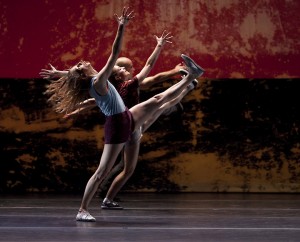 Sterling Ruby’s backdrop of multi-rectangles painted in splotchy colors was gorgeous, especially when Brandon Stirling Baker’s lights shifted the hues. But Peck’s costumes were awful; let’s just say Sidewalk Sale at Target. There were moments with a dark undertone, I think, and it conveyed emotion far better than Reflections. Since the entire company wore sneakers, and moved with boundless joy and delight more than anything related to murder (there is even a hoedown), the language of Robbins’ ballets, such as West Side Story, are evident. Especially appealing was having movement in synch with the music. A casual ballet was fine, but with a murky narrative, it soon became forgettable.
Sterling Ruby’s backdrop of multi-rectangles painted in splotchy colors was gorgeous, especially when Brandon Stirling Baker’s lights shifted the hues. But Peck’s costumes were awful; let’s just say Sidewalk Sale at Target. There were moments with a dark undertone, I think, and it conveyed emotion far better than Reflections. Since the entire company wore sneakers, and moved with boundless joy and delight more than anything related to murder (there is even a hoedown), the language of Robbins’ ballets, such as West Side Story, are evident. Especially appealing was having movement in synch with the music. A casual ballet was fine, but with a murky narrative, it soon became forgettable.
Fortunately, McKenna Birmingham and her flaming red hair ripped across the stage with the panache we had been looking for. Aaron Carr, short and bearded, exemplified the folk-infused choreography well, but he was more earthbound than his male counterparts. (Astoundingly, the cast was not listed in the program.)
* * * * * * * * * * * * * * * * * * * *
Sandwiched in between these marginally successful works was a “preview excerpt” from Hiroaki Umeda’s Peripheral Stream. It’s strange that L.A. is the company’s home base, but it is using us as a tryout city for a section of a piece which will see its World Premiere in entirety next month at Paris’ Théâtre du Châtelet, where Reflections premiered last May. Since neither of the longer works knocked it out of the park (everyone I asked sided with Reflections), I wonder how patrons will feel shelling out up to $125 a seat to see an evening that includes a boring 10-minute preview ($20 seats are available for each of the three performances).
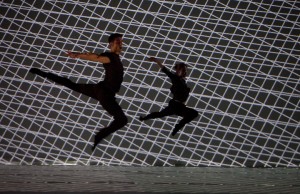 The only thing mesmerizing about Peripheral Stream was the visual technology (dance, sound, and visuals by Umeda). On a large screen behind four dancers are images best described as a snowy black-and-white TV screen flickering with wavy lines and overlapping images. The electro soundtrack includes humming, popping, and rat-a-tat-tats, sometimes intentionally sounding like a malfunctioning speaker. The hard-working dancers were mostly as static as the soundtrack, and completely swallowed by the technology, not enriched by it. At one point, they moved closer to the screen, creating an eerie silhouette like Carol Anne in Poltergeist. As a museum installation, it may have worked; but as a dance piece, it’s an abysmal failure. The only statement this dreck makes is equivalent to the opera Death and the Powers, which screened at the Hammer last week: Technology is getting in the way of true art, not enhancing it.
The only thing mesmerizing about Peripheral Stream was the visual technology (dance, sound, and visuals by Umeda). On a large screen behind four dancers are images best described as a snowy black-and-white TV screen flickering with wavy lines and overlapping images. The electro soundtrack includes humming, popping, and rat-a-tat-tats, sometimes intentionally sounding like a malfunctioning speaker. The hard-working dancers were mostly as static as the soundtrack, and completely swallowed by the technology, not enriched by it. At one point, they moved closer to the screen, creating an eerie silhouette like Carol Anne in Poltergeist. As a museum installation, it may have worked; but as a dance piece, it’s an abysmal failure. The only statement this dreck makes is equivalent to the opera Death and the Powers, which screened at the Hammer last week: Technology is getting in the way of true art, not enhancing it.
* * * * * * * * * * * * * * * * * * * *
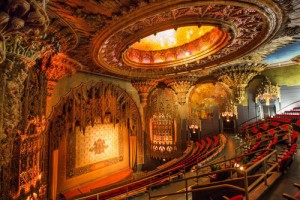 This theater, built in 1927 as United Artists, has been partially restored and has new seats. It is magnificent. A massive dome in the auditorium, covered with thousands of mirrored discs and crystal pendants, is encircled by an enormous sunburst. The astoundingly ornate Spanish Gothic features include vaulted, arched ceilings, intricate plaster and metalwork, and elaborately painted murals depicting Pickford, Fairbanks, and other Hollywood luminaries in scenes from epic myths. But it is dingy, the interior lighting is horrible, and it is dangerously dark in the balcony (it looks nothing like the photo). There are also no drinking fountains, so if you pay the extra $25 to “Meet & Greet” with the L.A. Dance Project dancers, the complementary drink is a glass of champagne—you still have to pay 3 bucks for a thimbleful of water.
This theater, built in 1927 as United Artists, has been partially restored and has new seats. It is magnificent. A massive dome in the auditorium, covered with thousands of mirrored discs and crystal pendants, is encircled by an enormous sunburst. The astoundingly ornate Spanish Gothic features include vaulted, arched ceilings, intricate plaster and metalwork, and elaborately painted murals depicting Pickford, Fairbanks, and other Hollywood luminaries in scenes from epic myths. But it is dingy, the interior lighting is horrible, and it is dangerously dark in the balcony (it looks nothing like the photo). There are also no drinking fountains, so if you pay the extra $25 to “Meet & Greet” with the L.A. Dance Project dancers, the complementary drink is a glass of champagne—you still have to pay 3 bucks for a thimbleful of water.
photos by Laurent Philippe and Rose Eichenbaum
LA Dance Project
The Theatre at Ace Hotel
929 Broadway in downtown Los Angeles
scheduled to end on February 22, 2014
for tickets, visit www.LADanceProject.com


{ 1 comment… read it below or add one }
Well said